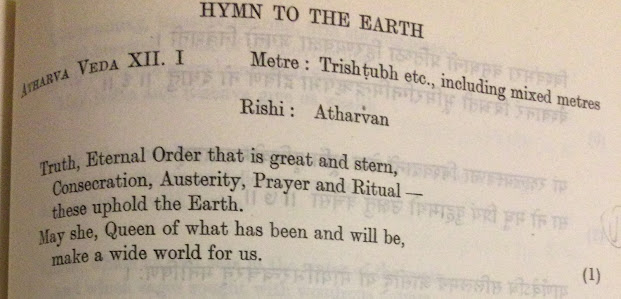

WRITTEN BY LONDON SWAMINATHAN
Post No. 10,479
Date uploaded in London – – 23 DECEMBER 2021
Contact – swami_48@yahoo.com
Pictures are taken from various sources for spreading knowledge.
this is a non- commercial blog. Thanks for your great pictures.
tamilandvedas.com, swamiindology.blogspot.com
Now I do more research into the Hymn to Earth in the 12th Book of Atharvana Veda (AV). It is incredible that one can sing such a long hymn with 63 Mantras/stanzas around 1000 BCE touching all aspects of the Earth, the Big Blue Marble.
The first Mantra is similar to one in Sangam Tamil literature though there is at least 1000 year gap between them. Both the Tamils and the Vedic seers were wondering what makes the earth clock ticking. How come this circular globe is not falling and still hanging in the middle of vast Space.
Hindu Vedas make three scientific statements even before the Western world did.
1.All through the Sanskrit literature we see Globular, Oval shape is attributed to Earth. Anda is the Sanskrit word for Egg and the Earth. They even use it for Universe with more pre fixes (Brahmanda, Akilanda ec. Tamils followed it in their later literature.
2.Hindus named all heavenly bodies including Sun and Moon as “Graha” which means Catch, Hold, Grab, Attract. English words such as Grip, Grab and Gravity came from this Sanskrit word; ‘Paani Grahanam’ is Holding Hand or Grabbing the hand of a woman which is used in Marriage invitations; Chnadra Grahana or Surya Grahana is ‘Shadow catching Moon and Sun’ (eclipse). So Hindus knew every heavenly body whether it is moon or mars, has Gravity
3.This shows that they knew earth is hanging in space but not falling down.

The first stanza or mantra says
“Truth, Eternal Order that is great and stern,
Consecration, Austerity, Prayer and Ritual—these uphold the Earth
May she, Queen of what has been and will be,
Make a wide world for us”.- AV 12-1-1
If at all the earth is existing today, it is because of the above good things.
Tamils also believed that good qualities only uphold the earth. Ilamperuvazuthi, a Pandya King, composed a poem (182 of Purananuru) which said that if the Tamils get even Indra’s Amrita (Nectar of Immortality) they wont eat it alone without sharing. Hospitality is praised throughout Vedic and Tamil literature. One must notice the Pandya king used Rig Vedic Sanskrit words ‘Indra’ and ‘Amrita’. The same king sang about Vishnu as well in another verse (See Paripatal) . He listed more good qualities in the poem.
Tiru Valluvar, author of Tamil Veda Tirukkural, also said the same in couplets 82, 996
“Even the nectar of immortality is not to be consumed,
Without sharing with the guests waiting outside”- Kural 82
Valluvar also mentioned Amrita in the above couplet.
In another couplet , he says,
“The world goes on smoothly, because of men of good breeding and culture;
But for them all this harmony would be buried in dust” – Kural 996
Cultured were called ‘Arya’ and uncultured, uneducated, criminals were called ‘Dasyus’.
In English they were called ‘Spurious’, opposite of Aryas
Spurious= Fake, False, Illegitimate
Xxx


Now let us compare it with AV ‘Hymn on Earth’.
The first stanza lists good qualities that uphold the earth — Truth, Austerity, Eternal Order/Rtm, Prayer and Ritual.
Truth and Eternal order (rutham) are praised sky high throughout the Vedas. Nowhere in the world we see such repetitions.
‘Rtm’ gives the word Rhythm in English.
‘Sathyam’ is Truth; Even English girls have the name Ruth.
And the Sanskrit word for austerity is Tapa (It becomes Tava in Tamil; P=V)
The Sanskrit word Tapas is used at least 50 times in Sangam literature and at least ten times in Post Sangam work ‘Tirukkural’.
2000 years ago Tamils were so familiar with Indra, Amrita and Tava , they used the exact Sanskrit words.
Another interesting comparison is Earth as Wife/Queen in AV and Earth as Prostitute in Tamil Purananuru of Sangam Period.
Later in AV, we see Earth as Mother. The poet who sang that song is Markandeyanar (Puram 365)
In Hinduism Kings are married to Earth i.e. Rajyalakshmi. So here the Tamil poet says, “Earth is crying that all the kings who married me left and I suffer like a prostitute (every king enjoys me but not staying with me). The poet emphasize the impermanence of life. The message is ‘even the greatest of Kings are gone but the earth is there permanently’.
So, it is alright for the Vedic poet to describe earth as Patni.
Last but not the least, the Vedic poet is talking about past and future of the Planet earth
Truth, Eternal Order that is great and stern,
Consecration, Austerity, Prayer and Ritual—these uphold the Earth
May she, Queen of what has been and will be,
Make a wide world for us.
This poetry is universal and not local. The poet has a perspective outlook. It is a priceless contribution of the AV to Vedic literature. The Vedic sage does not think of the earth in terms of only present but also the past and the future. The words Bhuta and Bhavishya in the first stanza would remind us the very first sloka in Vishnu Sahasranama where God is described as Bhuta, Bhavya and Bhavishya .

To be continued………………………….
tags- Bhumi sukta, Atharvaveda,